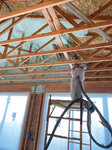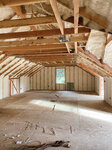


Extreme weather can get quite spendy for homeowners as their energy costs go up. By implementing basic home weatherization tips, homeowners can reduce energy loss and energy costs, as well.
Better-quality insulation and energy efficient building science during the 1990s created homes that helped keep the indoors at optimal temperatures. Buildings were also created with fewer but bigger studs, which created more room for insulation and reduced thermal bridging, Clark Public Utilities Public Information Officer Dameon Pesanti said.
“Washington State has very high standards in its residential energy codes,” Pesanti said. “Probably some of the highest in the nation. The general rule of thumb is that houses built after the ’90s have pretty good insulation in them.”
Washington homes built prior to the ’90s may need intensive weatherization upgrades, like additional insulation and sealing air leaks, to reduce energy bills.
“Older homes are excellent candidates to look into weatherizing,” Pesanti said.
Begin the weatherization process by adding additional insulation to the home. The attic and crawlspace are the easiest places to add insulation, Pesanti said. Insulation can also be added to pre-existing walls by using spray foam.
Reducing air leaks by filling gaps and insulating entry ways is important. Pesanti noted uninsulated outlets, lighting fixtures, exterior pipes, doors and windows can all leak air. Even the gaps along floorboards, which allow material expansions and contraction, can leak air. Pesanti suggests filling those gaps.
“If there is a gap there, between the floor and the wall, it’s a good idea to stick this stuff called backer rod in. It will compress and expand as the materials around it do,” Pesanti said.
While a single source of air leakage isn’t severe, when air leaks across a whole home are considered, it can result in considerable energy loss, Pesanti said.
Some insulating material may need periodic replacement, such as the weather stripping around windows and doors. The frequent motion and rubbing against the weather stripping can wear the material, Pesanti said.
Home weatherization can be done by homeowners, but some tasks are better left to professionals, Pesanti said.
“A pretty handy person could do a good job, but for it to be done extremely well, it’s worth calling a professional in to do this,” Pesanti said. “A weatherization company will come in and look at your whole house.”
Professional insulator Nick Urban at Spray On Foam & Coatings, located in Battle Ground, uses expanding foam to coat homes. The foam seals air leaks and expands snugly into insulation zones.
“The ceiling of the home is the leakiest part in most structures. The first place foam is generally used is the roof,” Urban said.
Pre-existing walls can be reinforced with spray foam. The drywall does not have to be removed, and the process is minimally invasive. A half-inch hole is drilled into the wall and foam insulation sprayed directly into the stud bay, Urban said.
Before beginning a spray foam weatherization project, Urban cautions homeowners to seek professionals with trained spray-foam technicians.
“Spray foam is not a heavily licensed industry like electrical or plumbing. This has led to some black eyes for the industry. Problems can arise if the foam is not installed by a properly trained technician,” Urban said. “Since we are essentially manufacturing a product in place on site, the techs need to have a good understanding of what it is that they are doing.”
Home weatherization can be expensive, but many federal and local incentives are available to discount home remodeling. The federal Energy Efficient Home Improvement Credit, which began Jan. 1 2023, gives homeowners up to a 30% tax credit of qualified renovation costs. A maximum yearly credit of $1,200 is available for certain energy efficient home improvements, according to the IRS.
Clark Public Utilities offers weatherization programs, which provides incentives for improvements to existing homes and manufactured homes with electric heating. Low-income and multi-family property weatherization programs are available. Renovations must be completed by a contractor within the Clark Public Utilities network to be eligible for incentives.
For more information about weatherization and incentives, view Clark Public Utilities weatherization program at clarkpublicutilities.com/residen tial-customers/reduce-energy-waste-and-lower-your-bill/. For federal incentives, visit irs.gov/credits-deductions/energy-effi cient-home-improvement-credit.